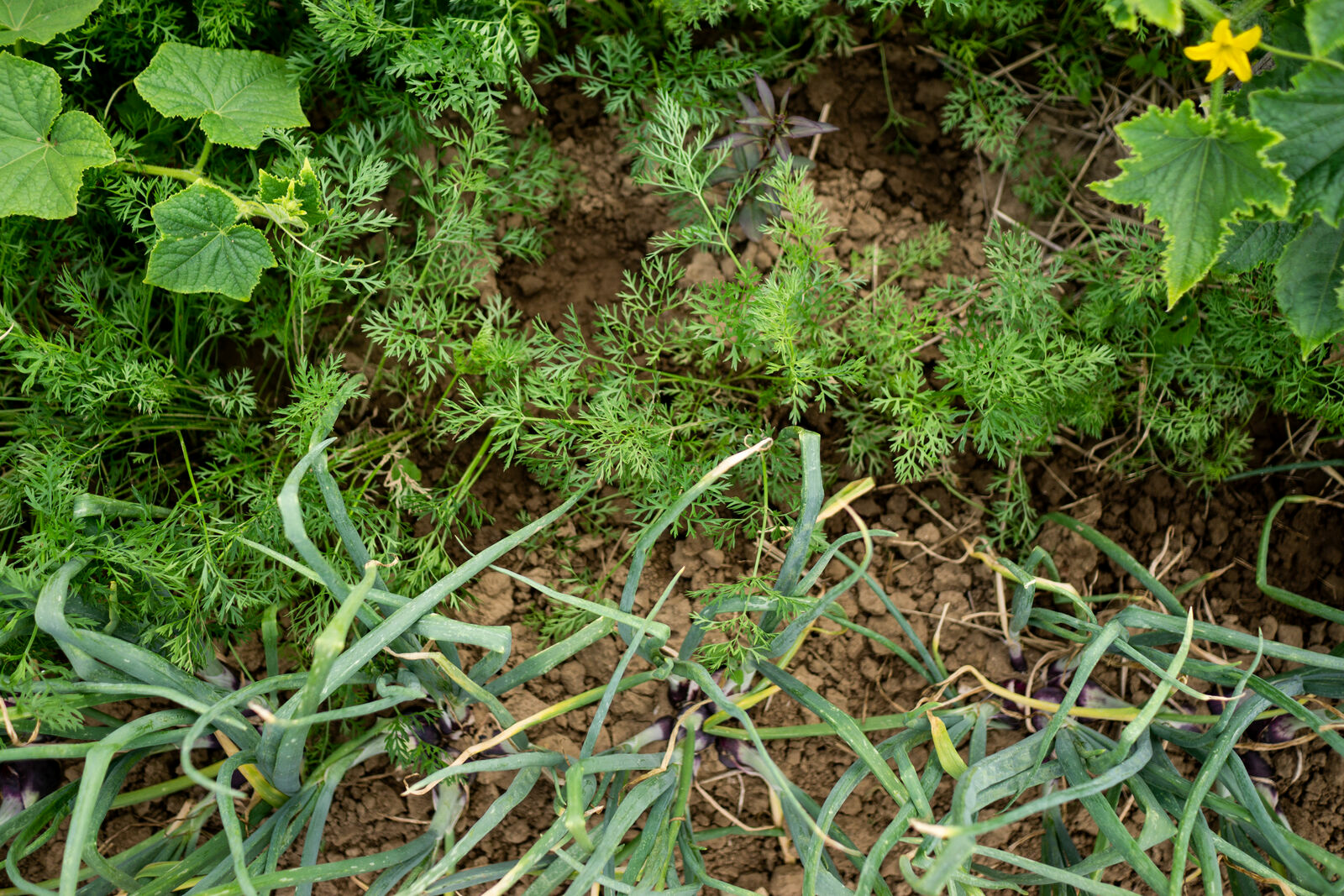
Companion Plants for Onions: What to Plant With Onions?
Onions are a great addition to any vegetable garden. They are easy to grow and very healthy. In this article, you will find an overview of the companion and antagonistic plants of onions, what you should consider when rotating crops with onions, and an example planting plan for companion planting with onions.
This Article Contains:
- Companion planting with onions: suitable neighbors
- Companion plants for onions
- Keeping onion flies away: How to do it
- What not to plant with onions?
- Table: Companion plants for onions
- Succession planting & crop rotation with onions
- Growing onions in the raised bed & garden - a planting plan for the onion bed
- Frequently asked questions: Onions in a mixed culture
Quick Overview
What to plant next to onions?
- Carrots, garlic, tomatoes, cucumbers, strawberries, lettuce, parsley
- No cabbage, peas or beans
Onions in companion planting: succession planting & crop rotation
- Succession planting: Do not plant onions or other allium plants in succession in the same place during a season
- Pre-crops: spinach, lettuce, radishes
- Subsequent crops:
- Summer onions: Winter-hardy crops that can already be planted in the bed in summer, such as lamb's lettuce, winter-hardy cabbages or green manure
- Autumn bulbs: pre-grown plants such as cucumbers, tomatoes, zucchinis or peppers
- Crop rotation: take a cultivation break of 3-4 years so that diseases and pests cannot establish themselves
Companion planting with onions: suitable neighbors
Companion planting with onions has many advantages. You improve your harvest as pests and diseases are kept away better. You also make more effective use of the space and nutrients in your bed. Companion planting can also improve the taste of your vegetables. Onions can be grown together with some plants, even with some plants from your own plant family, such as garlic. However, some vegetables should not be grown alongside onions. Below you can find out which plants go well with onions and which are better planted in a different bed.
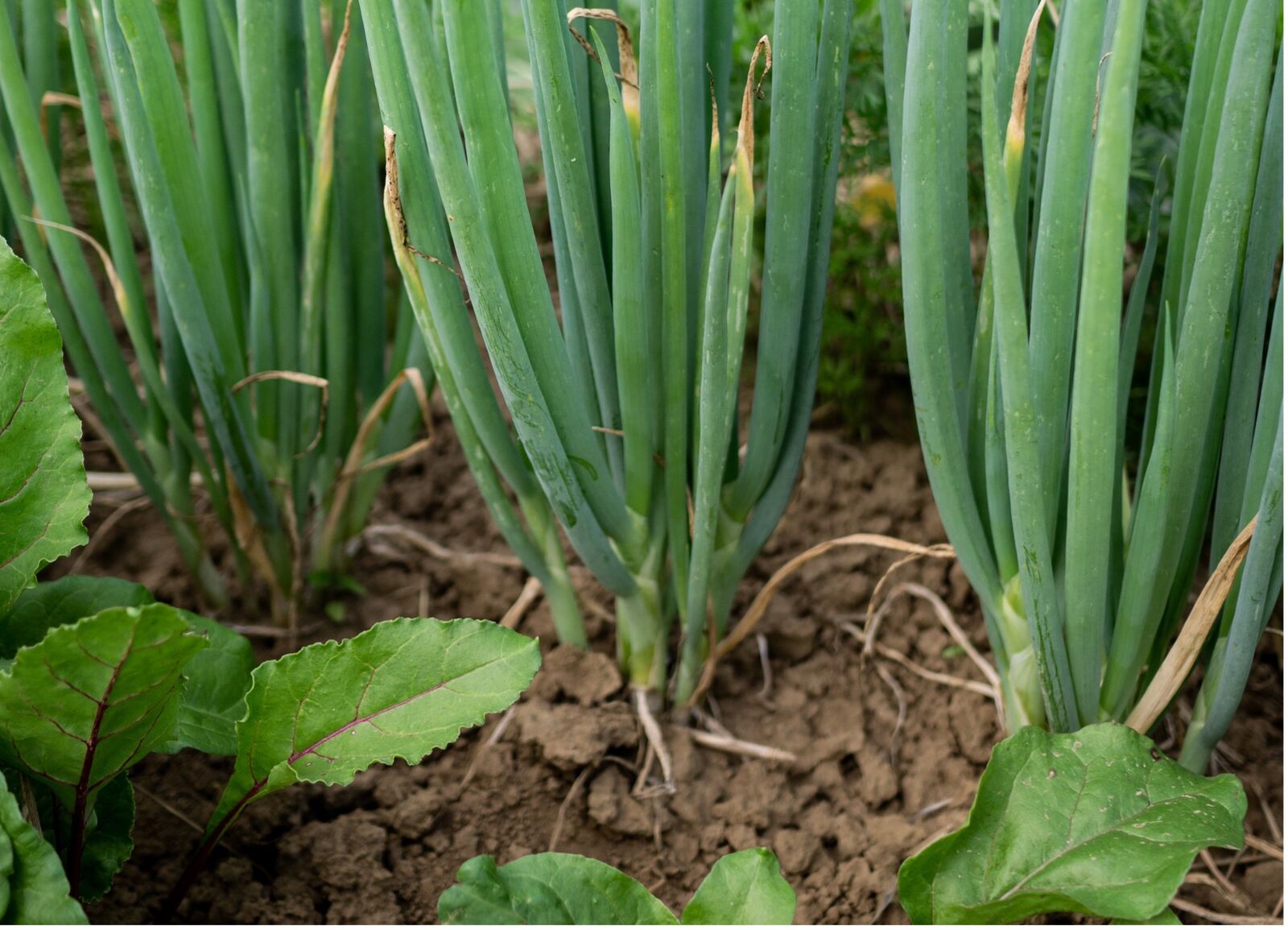
Companion plants for onions
Good companions for onions help to keep your onions healthy and ensure a good harvest. You can find an overview of companion and antagonistic plants in the mixed crop table section. Some examples of companion plants are listed in the next sections:
Planting carrots & onions together
Onions and carrots are good bed partners as they complement each other in a few ways. For one thing, onions help to keep the carrot fly away from your carrot plants. Because while the carrot fly loves the smell of carrots, it doesn't like the smell of onions at all. This protects your plants and they grow healthier.
Secondly, carrots and onions have roots of different depths. Carrots form long, narrow roots that reach deep into the soil. Onions, on the other hand, form shallow roots that spread more horizontally. This means that the two plants do not compete for nutrients or water in the soil, which promotes their growth.
In addition, onions can even improve the flavor of your carrots. Onions contain sulphur compounds that help to intensify the flavor of companion plants.
Tomatoes and onions as plant companions?
As with carrots, onions are companion plants for tomatoes as they keep pests such as whitefly, thrips, aphids and spider mites away from your tomato plants with their scent. Underground, onions also keep voles out of the bed. If tomatoes and onions grow next to each other, your plants will be better protected from infestation. Onions can also improve the taste of your tomatoes.
The roots of tomatoes and onions also differ in their growth. Tomatoes tend to develop deep, spreading roots. Whereas onions have shallow, horizontal roots. As a result, they complement each other in their growth and do not take nutrients away from each other.

Plan your mixed crop now!
With our bed planner, you can easily plan a colourful mixed crop. Good and bad neighbours are displayed directly and you get tips on succession planting and crop rotation!
Plan your bed nowDo garlic and onions go together?
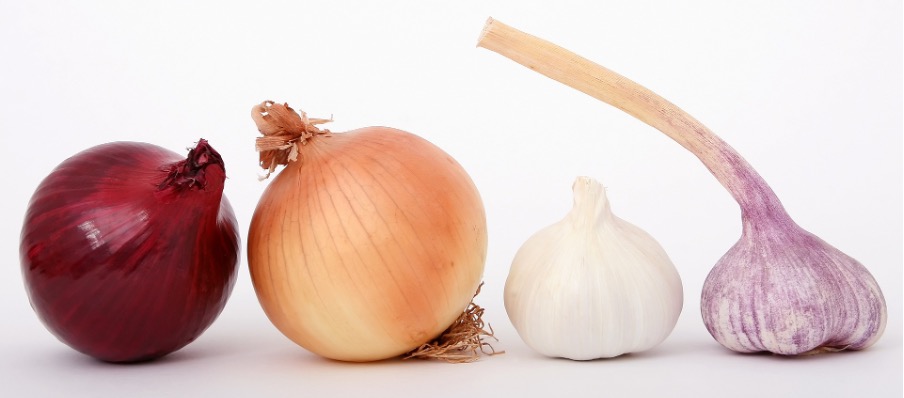
Garlic and onions are both Allium plants and can be planted well together. They help each other by keeping insects such as aphids away, providing natural protection against pests without the use of pesticides. The two plants also complement each other in their growth and therefore do not take nutrients away from each other. In addition, the two plants can improve the taste of each other, as they contribute to improving the aroma through their fragrances. Garlic is also antibacterial and can therefore protect against certain diseases.
Are cucumbers and onions good bed partners?
Cucumbers and onions are good companions, as cucumbers need a lot of space and can therefore cover the soil around the onions. Onions also loosen the soil, which prevents waterlogging. Cucumber plants do not like waterlogging at all. They complement each other in their growth, allowing you to make optimum use of the space and nutrients in your bed. Onions can also protect cucumber plants from pests and improve the taste of your cucumbers.
Place the onion between the strawberries
Planting onions between strawberries is a good idea as they keep away slugs and other pests that like to feed on your strawberry plants. Onions can also loosen up the soil and help to release nitrogen, which is important for strawberry growth. However, strawberries don't need that much nitrogen and are more susceptible to disease if they have too much nitrogen, so you shouldn't give your strawberries extra fertilizer. They complement each other in growth and improve the taste of your strawberries.
Keeping onion flies away: How to do it
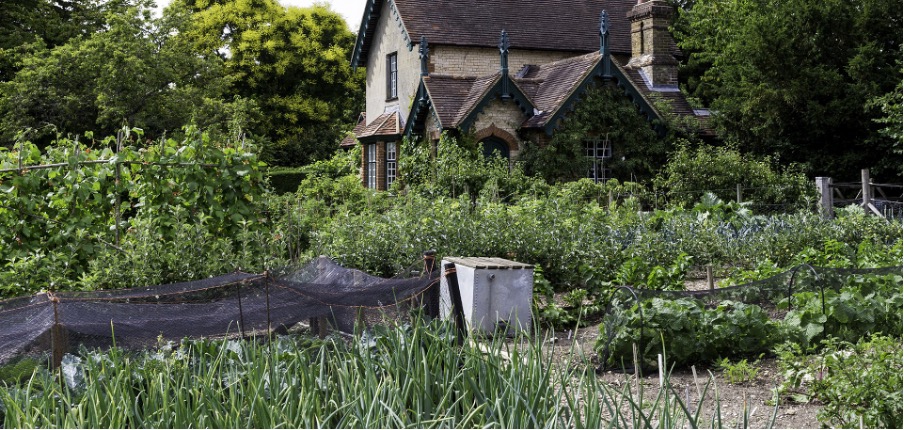
Image by Ron Porter on Pixabay.
The onion fly is a common problem when growing onions. In addition to good plant companions, there are other ways to protect your onion plants from infestation. A combination of options will help to keep your plants healthy:
- Plant onions next to garlic as natural protection against onion flies. Garlic contains chemical compounds that deter onion flies, as do carrots, cabbage and beans , although cabbage and beans are otherwise not such good companions for onions.
- Cover the onions: Use garden fleece or crop protection netting to prevent onion flies from laying their eggs on the plants.
- Plant at a different time of year: The onion fly usually lays its eggs in spring. If you plant your onions in the fall, they will have more time to grow before the onion flies become active. This makes them more resistant to infestation.
- Rotate your crops: The onion fly can settle in the soil and overwinter. Rotating your crops every year can help to reduce onion fly infestation.
You can find out more about how to recognize and naturally control pests in our article Plant pests in the garden.
What not to plant with onions?
Some plants do not get along well with onions. These include beans and peas, as well as cabbages. The essential oils that onion plants spread do not benefit the growth of cabbage. In addition, you should not grow plants with similar root growth to onions in their vicinity. These include radishes, for example.
Planting beans with onions?
Beans and onions should not be planted together, as onions impair the growth of beans. Beans also fix nitrogen in the soil. If the soil is already rich in nitrogen, this can harm the onions, as they do not tolerate too much nitrogen well and become more susceptible to diseases and pests. To still benefit from the fact that beans keep the onion fly away, you can plant the beans a little further away in the same bed.
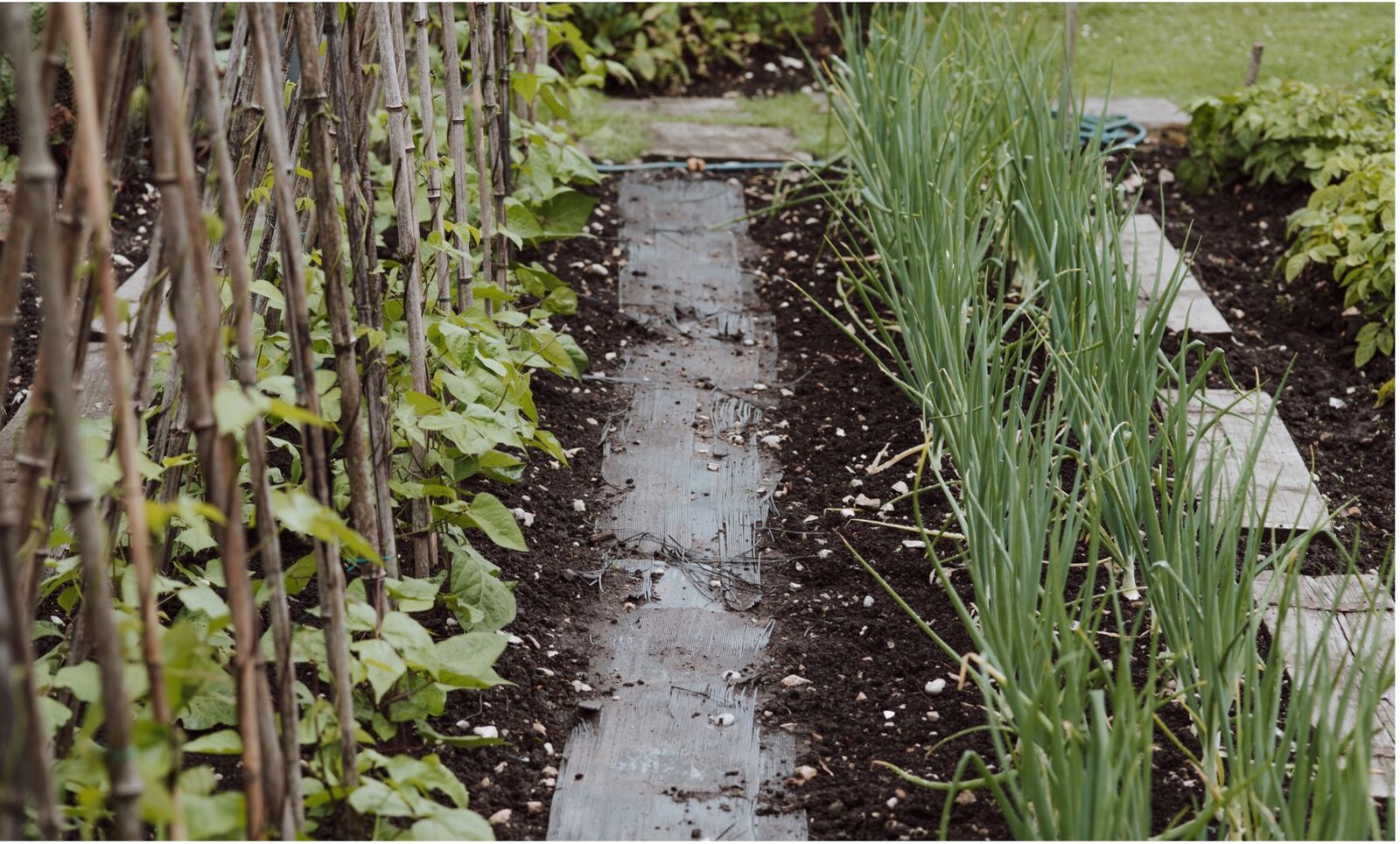
Photo by Annie Spratt on Unsplash.
Table: Companion plants for onions
Here you will find a list of the companion plants and antagonistic plants for spring onions in the companion planting table. The companion plants of spring onions are a little different, as they grow slightly differently, but all good companions of spring onions are also good companions for spring onions. You can find a list of the companion and antagonistic plants of spring onions in our encyclopedia. Due to their short growing period and smaller space requirements, they can even be planted next to cabbages, peas and beans, unlike spring onions:
| Companion plants | Antagonistic plants |
|---|---|
| Lettuce (garden & lamb's lettuce, radicchio) | Beans |
| Carrots | Peas |
| Garlic | Cabbages (white cabbage, head cabbage, Brussels sprouts, kohlrabi, etc.) |
| Beetroot | Radishes |
| Tomatoes | Artichokes |
| Cucumber | Jerusalem artichokes |
| Strawberries | Pumpkin |
| Peppers/Chilli | Soy beans |
| Zucchini | Asparagus |
| Rocket | |
| Sunflowers & Camomile | |
| Herbs (Dill, Parsley, Marjoram, Oregano) | |
| Black salsify | |
| Physalis |
Succession planting & crop rotation with onions
Succession planting and crop rotation are important concepts when it comes to growing vegetables. Good rotation plants and a sufficiently long crop rotation help to keep the soil healthy and reduce the risk of pests and diseases. Here are some tips for succesion planting and crop rotation with onions:
Succession planting
Good succession plan ensures that the soil in your garden is not depleted and remains healthy. To do this, you should not grow successive heavy feeder crops in the same place in the bed, or plants from the same family. Otherwise you will encourage diseases and pests and the growth of your plants will be inhibited.
As onions can be planted or sown in the bed early in the year, you may be able to grow fast-growing species such as lettuce, spinach or radishes beforehand. These crops have a short growing time and can be sown a little earlier, depending on the variety.
Depending on the cultivation period from spring to summer or fall to spring, there are different subsequent crops for onions. When growing summer on ions, over-wintering crops such as lamb's lettuce, cabbages or green manure are suitable as catch crops. If you are growing autumn onions, the bed will be free again from June, so you can then grow pre-grown plants such as cucumber, zucchini, pumpkin, tomatoes or peppers in the same place.
Crop rotation
After growing onions in one place in the bed, you should not grow onion plants or other allium plants there again the very next year. You should take a cultivation break of 3 - 4 years. Otherwise you will encourage the colonization of pests or diseases.
Growing onions in the raised bed & garden - a planting plan for the onion bed
In this planting plan you will find an example of a companion planting bed in which onions can be grown all year round. You can grow onions from spring right through to winter and enjoy their flavour in dishes. Good neighbours such as carrots, garlic, lettuce and strawberries grow together with onions in the bed. This means you have onions in your garden all year round and the different onion varieties provide variety when cooking.
Main crops for the summer in the onion bed
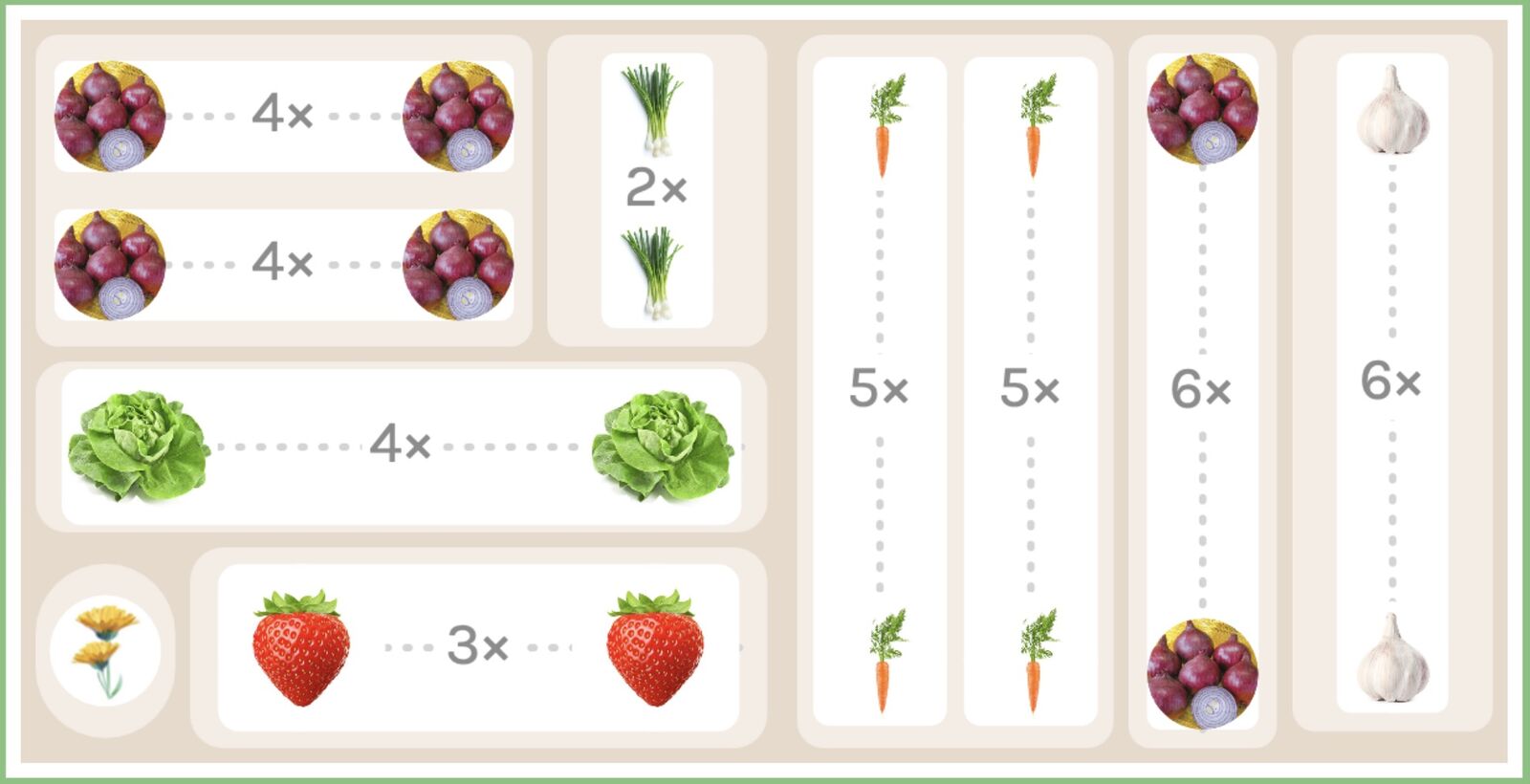
Pre-cultivation: planting onions in spring
In spring, from March/April, you can sow or plant out your onions in the garden, depending on whether you use seeds, onion sets or pre-grown plants. You can find out more about growing onions in our article Planting, growing and harvesting onions. You can grow lettuce, strawberries and some flowers together with onions in spring. Lamb's lettuce and broccoli are last year's crops and are still in the field. Spring onions can be sown very early, a few weeks before onions. You can also grow the two species together in the same bed. As spring onions can be harvested after just a few weeks, it is best to sow them in sets. This way, you will always have a supply of spring onions throughout the season, as unlike onions, they cannot be stored fresh for long. You can find out more about when to harvest onions and how to store them in our article Harvesting and storing onions.

Subsequent crops: planting onions in the fall - planting winter onions
If you plant onions in the fall, you can plant winter onions. Winter onions are onions that remain in the ground throughout the winter and can be harvested in the spring. There are some varieties of edible onions that can be grown over the winter. Make sure that you do not plant onions one after the other in the same place and that your bed receives nutrients in between through compost, manure or green manure. You can do this in the fall. However, you should not work compost into the soil immediately before planting onions, as onions do not tolerate too much nitrogen in the soil. Garlic can also be grown together with onions in winter. It is planted out in the fall and can then be harvested the following year.
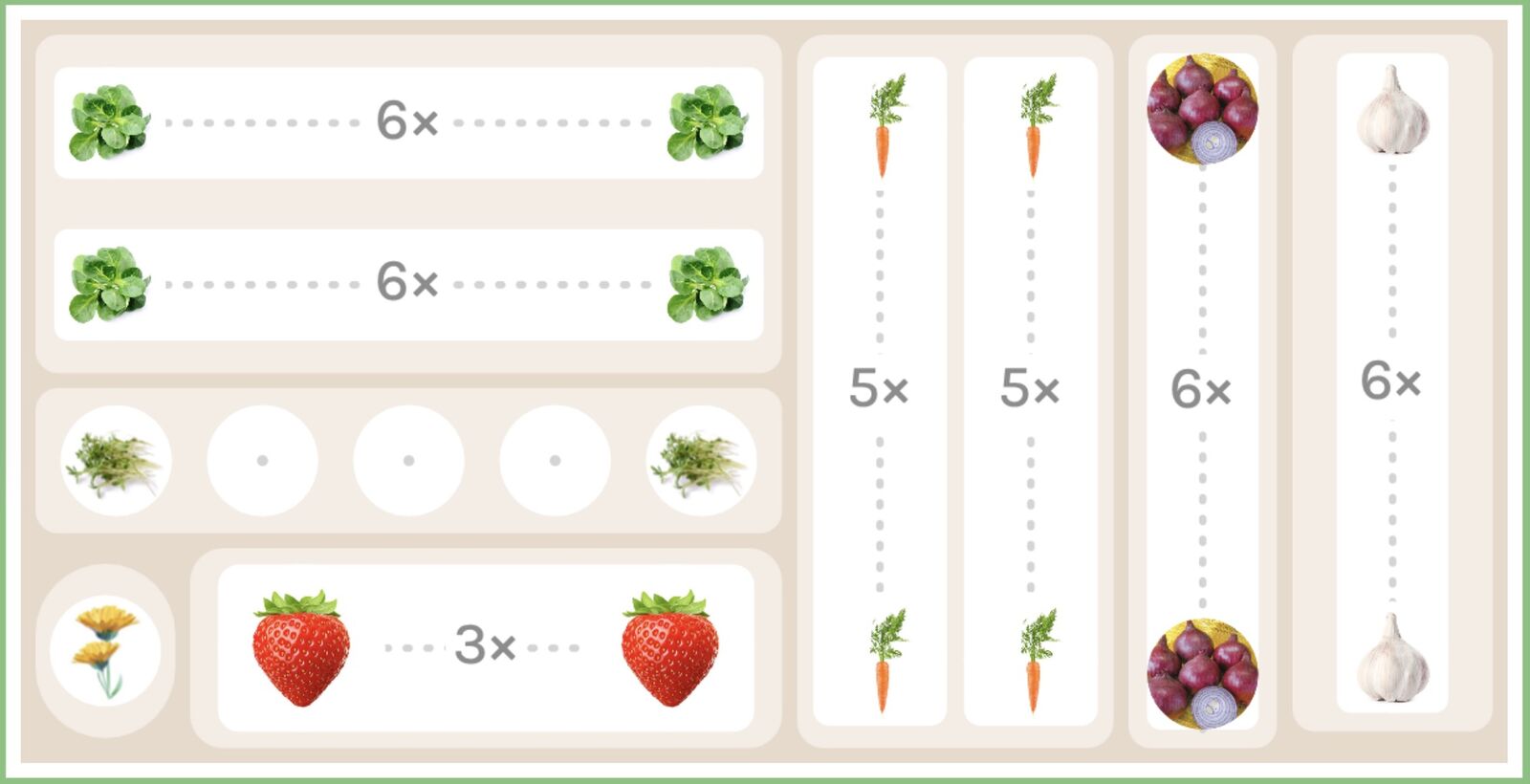
If you have any questions or comments, please write to us at magazin@fryd.app. Would you like to receive helpful gardening tips all year round and plan your own beds optimally? Then register here or download the Fryd app for Android or iOS.
Fryd - your digital bed planner
Marielena
Current Topics in the Community
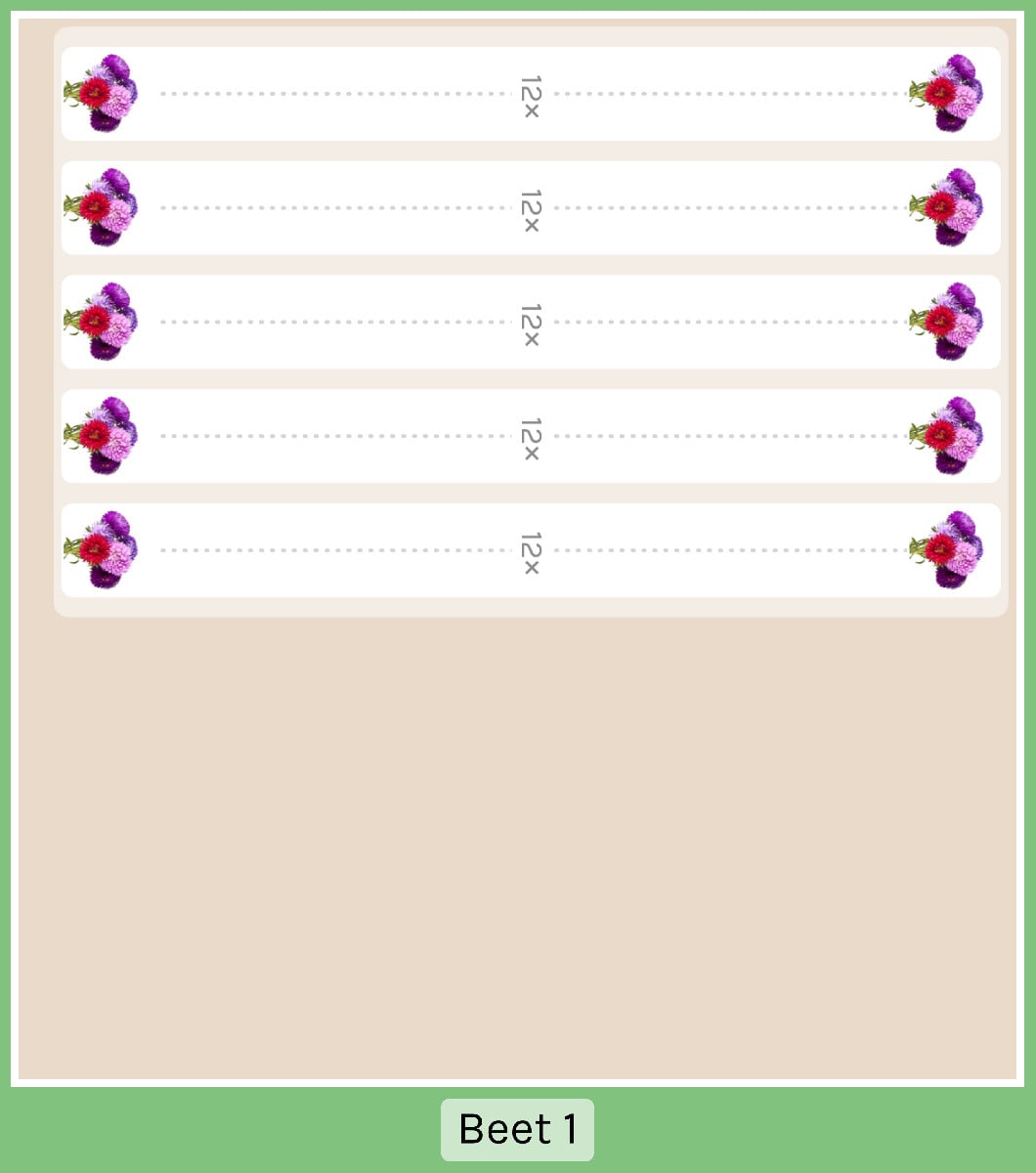
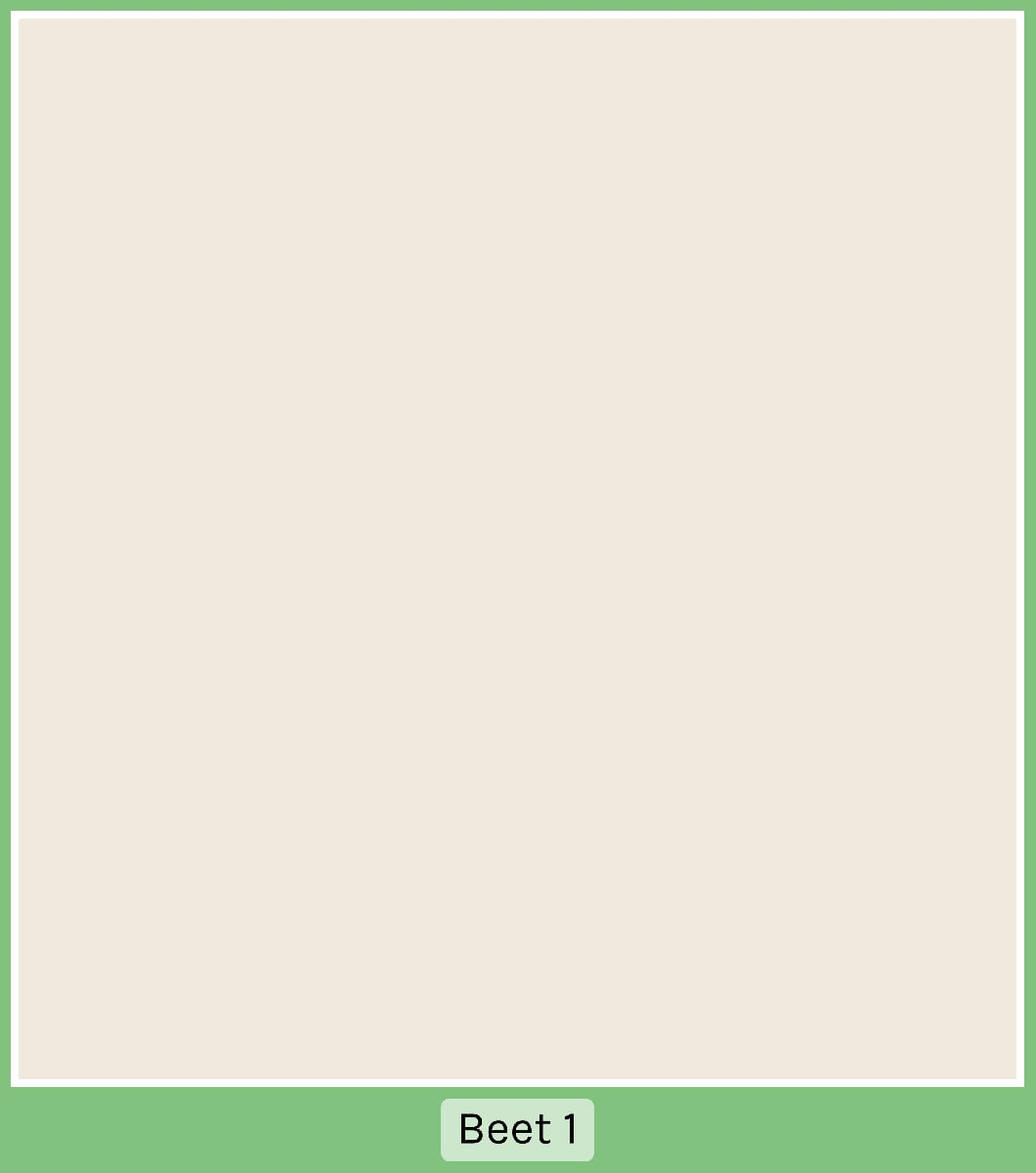

Liked 1 times
@Ufrydpaid_01
Popular Articles

Companion Plants for Carrots: What (Not) to Plant With Carrots

Companion Plants for Celery : What (Not) to Plant With Celery?

Strawberry Types: List of Best Strawberry Varieties

Companion Planting With Strawberries: Companion Plants and Planting Plan

Basil Varieties & Types at a Glance

What to Plant With Cabbage: Good and Bad Companion Plants

Fertilizing Strawberries: Home Remedies & Natural Fertilizers at a Glance

Growing Sweet Potatoes: Tips on Cultivation & Companion Plants

Companion Plants for Kitchen Herbs: Chives, Parsley & Co

What Herbs Can Be Planted Together?
FAQ
Companion plants for onions include carrots, garlic, strawberries, lettuce, parsley, cucumbers, tomatoes, zucchini, beet, dill and chamomile.
What not to plant with onions?
Bad neighbors for onions include beans and peas, as they add nitrogen to the soil. Too much nitrogen is not good for the growth of onions. You should also avoid planting cabbages next to onions, as onions emit essential oils that are not good for cabbages.
Can you plant tomatoes and onions together?
Yes, tomatoes and onions can be planted together as they have different root depths and there is no competition for nutrients and water in the soil. Onions also keep pests such as whitefly and aphids away and protect the tomatoes from infestation.
Are onions and carrots companion plants?
Yes, onions and carrots are companion plants, as they do not interfere with each other's growth and also keep pests away. Onions can also improve the taste of carrots.
Can onions and kohlrabi be planted together?
You should not grow onions next to kohlrabi or other types of cabbage, as onions give off essential oils that are not good for the growth and health of kohlrabi and cabbage.